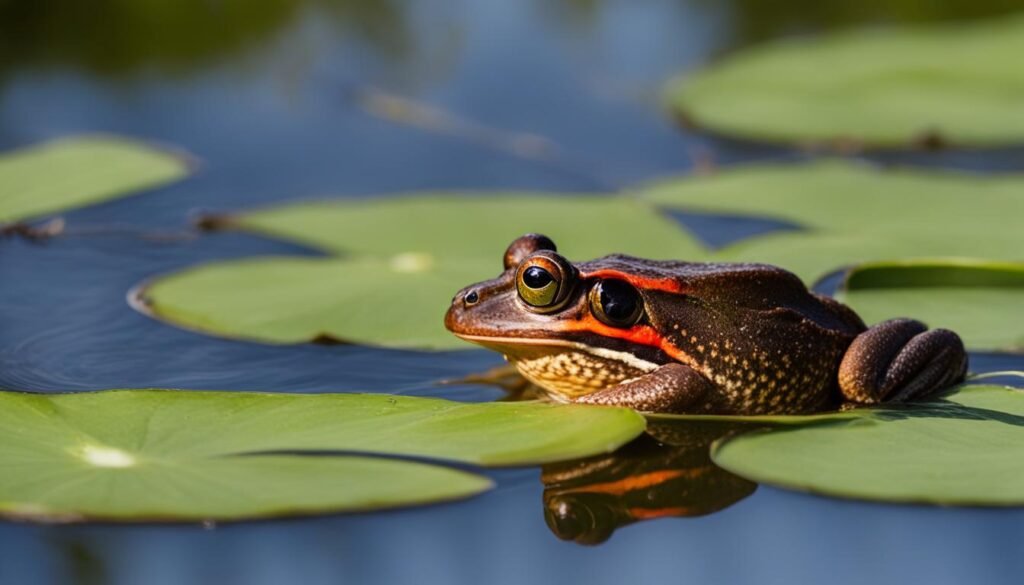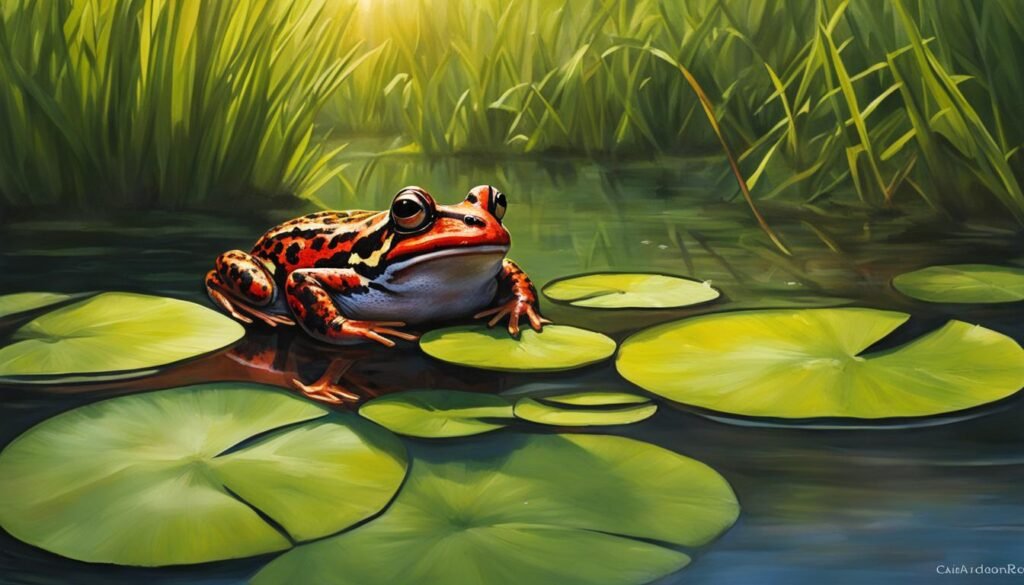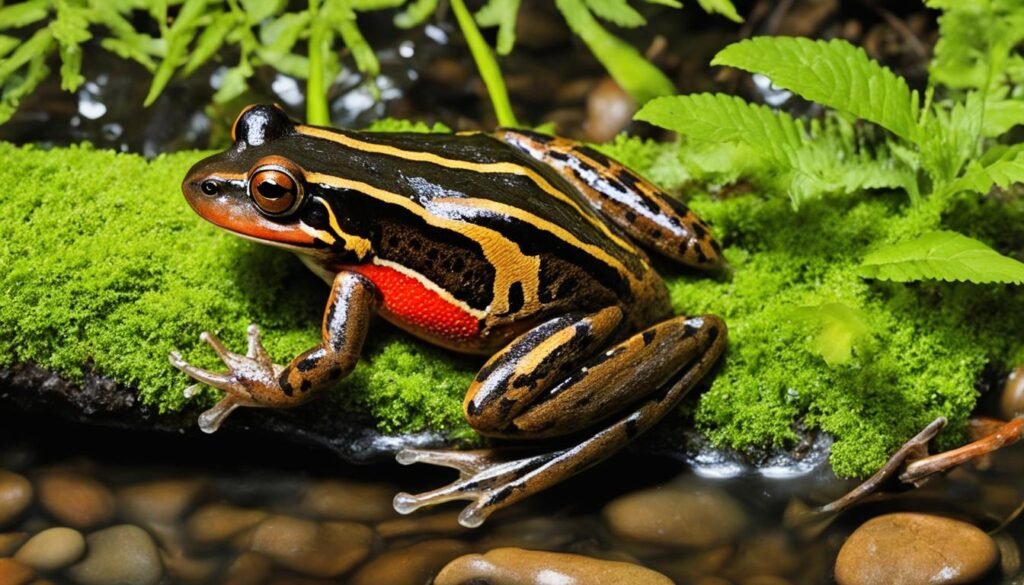Welcome to my guide on the California red-legged frog, the beloved amphibian species native to the state of California. In this article, we will explore the conservation efforts being made to protect this endangered species and preserve its habitat. The California red-legged frog, known for the reddish coloring on the underside of its legs and belly, has faced numerous challenges, including invasive species, habitat loss, and overexploitation. However, through dedicated conservation efforts and wildlife preservation initiatives, we can work together to ensure the survival of this remarkable creature.
Key Takeaways:
- The California red-legged frog is a rare amphibian species found mainly in California.
- Conservation efforts aim to protect the frog’s habitat and preserve its population.
- The frog is legally protected and recognized as the official state amphibian of California.
- Invasive species and habitat loss are major threats to the frog’s survival.
- Conservation organizations play a crucial role in preserving the California red-legged frog.
Description and Range of the California Red-Legged Frog
The California red-legged frog, also known as the California state amphibian, is a remarkable species that is native to California. It holds the distinction of being the largest native frog in the western United States, measuring between two to five inches in length. Its striking red to brown or gray coloration, adorned with black spots and blotches on its back and legs, makes it a distinctive and visually appealing amphibian.
While the California red-legged frog historically thrived throughout most of California’s coastal areas, its population has significantly declined over the years. Today, it has a range almost exclusively in California, with a few rare sightings in Mexico. This beautiful frog requires specific habitats to survive and reproduce successfully. Slow-moving or standing deep ponds, pools, and streams with tall vegetation provide ideal conditions for its protection from predators and excessive heat.
As an endangered species, the California red-legged frog faces numerous threats to its survival. However, concerted conservation efforts and wildlife preservation initiatives are underway to protect and restore its dwindling population. By safeguarding the habitats in which it thrives and honoring its ecological importance, we can contribute to the long-term conservation and protection of this cherished native species.
- Largest native frog in the western United States
- Ranging between two to five inches in length
- Distinctive coloring with black spots and blotches
- Historically found in California coastal areas
- Requires slow-moving or standing deep ponds, pools, and streams
- Dependent on tall vegetation for protection and survival
Diet and Life History of the California Red-Legged Frog
The California red-legged frog, a native frog species of California, has a diverse diet. These frogs are opportunistic eaters, consuming a variety of prey that can fit in their mouths. Their diet includes invertebrates, smaller amphibians, and even small mammals. This versatility in their diet allows them to adapt to different environments and food availability.
Breeding for California red-legged frogs occurs from November to April. During this time, male frogs arrive early at breeding sites and call out to attract females. Once a female is attracted, she lays large egg masses, and the males fertilize them. These egg masses can contain hundreds of eggs at a time.
After the eggs are laid and fertilized, they undergo a period of development. The eggs hatch into larvae, which live in water and breathe through gills. Over the summer months, these larvae undergo metamorphosis, gradually developing into adult frogs.
The California red-legged frog can live up to 10 years in the wild, depending on various factors such as habitat quality and predation pressure. Throughout their life cycle, these frogs play an important role in the ecosystem as both predators and prey, contributing to the balance of the native amphibian population.
Threats to the California Red-Legged Frog
The California red-legged frog, a protected species, faces several threats that endanger its population. These threats include invasive species, habitat loss, overharvesting, and the depletion of water resources.
Invasive Species
One of the major threats to the California red-legged frog is the presence of invasive species such as the American bullfrog. These invasive frogs compete with the native red-legged frogs for resources and habitat, leading to a decline in the population of the California red-legged frog.
Habitat Loss
Agricultural and urban development have caused significant habitat loss for the California red-legged frog. Wetlands and ponds, which are crucial for the frogs’ breeding and survival, have been destroyed or degraded due to these human activities. This loss of habitat limits the available space for the frogs and makes it difficult for them to find suitable breeding grounds.
Overharvesting
Historically, the California red-legged frog was overharvested for food. This unsustainable harvesting further contributed to the decline in their population. Strict regulations and conservation efforts have been implemented to protect the frogs from further exploitation and support their recovery.
Depletion of Water Resources
The depletion of water resources is a significant threat to the California red-legged frog. As water sources diminish, the frogs’ habitat for breeding and survival becomes compromised. The loss of suitable aquatic environments, such as ponds and streams, limits the frogs’ ability to reproduce and thrive.
In response to these threats, wildlife management and habitat restoration efforts are being implemented. Conservation organizations and government agencies are working together to protect and restore the habitats of the California red-legged frog, ensuring its continued survival and contributing to the overall preservation of wildlife in the region.
The California red-legged frog is facing threats to its population due to habitat loss and invasive species.
Conservation Efforts for the California Red-Legged Frog
Conservation organizations have been working tirelessly to protect the California red-legged frog. Through their dedicated efforts, important steps are being taken to preserve this unique species and the ecosystems it inhabits.
Habitat preservation and restoration initiatives play a crucial role in these conservation efforts. By creating and maintaining suitable environments for the frog’s survival and breeding, conservationists aim to ensure the long-term viability of the population. This includes protecting wetland ecosystems, which serve as vital habitats for the red-legged frog and numerous other species.
Conservation organizations also recognize the ecological importance of the California red-legged frog. By conserving this amphibian population, they contribute to the overall biodiversity conservation and the delicate balance of the ecosystem. The interconnectedness of species within these habitats is vital for maintaining healthy and thriving ecosystems.

Through their actions, conservation organizations are not only safeguarding the red-legged frog but also promoting the preservation of wildlife in California. The preservation of this native frog species serves as a testament to our commitment to environmental stewardship and the long-term health of our natural surroundings.
Legal Protection and Recognition of the California Red-Legged Frog
The California red-legged frog, native to California, is not only a protected species but also holds the prestigious title of being the official state amphibian. As a threatened species, it benefits from legal protection under the Endangered Species Act, highlighting the importance of conserving its habitat and population.
The recognition of the California red-legged frog as the official state amphibian showcases the state’s commitment to wildlife protection and conservation. This designation serves as a reminder of the frog’s significance and the need to safeguard its existence for future generations.
These legal protections ensure that appropriate measures are taken to preserve the red-legged frog’s habitat, mitigate threats, and promote its population recovery. By enforcing legislation and regulations, we can work towards the conservation of this native species in California.
- Protected under the Endangered Species Act
- Official state amphibian of California
- Reflects the state’s dedication to wildlife protection
- Emphasizes the need for habitat conservation
- Supports the restoration of the frog’s population
Efforts by Conservation Organizations for California Red-Legged Frog
Conservation organizations play a vital role in the preservation of the California red-legged frog. These organizations, such as the California Regional Center, are actively involved in efforts to protect and conserve the red-legged frog’s population and habitat.
One of the key areas of focus for conservation organizations is habitat preservation. They work towards creating and maintaining suitable habitats for the red-legged frog to thrive. This involves preserving and restoring wetland ecosystems that are essential for the frog’s survival.

Conservation organizations also prioritize wildlife management strategies to ensure the long-term conservation of the red-legged frog. They monitor frog populations, study their behavior, and implement measures to mitigate threats and promote the frog’s well-being.
In addition, outreach and educational initiatives are crucial for raising awareness about the importance of conserving the red-legged frog. Through various programs and campaigns, conservation organizations engage with communities, schools, and individuals to foster appreciation for the species and encourage active participation in its conservation.
By collaborating with relevant stakeholders and harnessing resources, these organizations are making significant strides in safeguarding the red-legged frog’s future. Their efforts contribute to the overall conservation of biodiversity and the preservation of California’s natural heritage.
Conclusion
The California red-legged frog is an endangered species that requires urgent conservation efforts to protect its survival. With habitat loss and invasive species posing significant threats, the future of these cherished amphibians hangs in the balance. However, there is hope for their recovery through the combined efforts of conservation organizations, wildlife preservation initiatives, and habitat restoration projects.
To ensure the long-term conservation and protection of the California red-legged frog, it is crucial that we raise awareness about their plight and take decisive action. By supporting and participating in conservation efforts, we can contribute to preserving this iconic species for future generations. Additionally, the restoration of their natural habitats is essential for their survival, as well as maintaining the ecological balance and biodiversity of California’s wetland ecosystems.
Together, we have the power to make a difference in the preservation of the California red-legged frog. By valuing the importance of wildlife conservation, we can create a sustainable environment where this endangered species can thrive. Let us embrace our role as stewards of nature and work towards a future where the red-legged frog of California continues to grace our wetlands with its presence.
FAQ
What is the California red-legged frog?
The California red-legged frog is a rare amphibian species found almost exclusively in the state of California. It is named for the reddish coloring on the underside of its legs and belly.
What is the size and range of the California red-legged frog?
The California red-legged frog is the largest native frog in the western United States, measuring between two to five inches in length. It has a range almost exclusively in California, with a few sightings in Mexico.
What does the California red-legged frog eat?
The California red-legged frog is an opportunistic eater, consuming a variety of prey that can fit in its mouth, including invertebrates, smaller amphibians, and mammals.
What are the threats to the California red-legged frog?
The California red-legged frog faces threats such as invasive species, habitat loss due to agricultural and urban development, overexploitation, and depletion of water resources.
How are conservation efforts protecting the California red-legged frog?
Conservation efforts include habitat preservation and restoration, wildlife management, and raising awareness about the importance of protecting this native species.
Is the California red-legged frog legally protected?
Yes, the California red-legged frog is legally protected as a threatened species under the Endangered Species Act. It is also recognized as the official state amphibian of California.
What are conservation organizations doing to save the California red-legged frog?
Conservation organizations are actively working on habitat preservation, wildlife management, and restoration of wetland ecosystems to protect the California red-legged frog.
How can I contribute to the conservation of the California red-legged frog?
You can contribute by supporting conservation organizations, spreading awareness about the importance of protecting this species, and participating in habitat restoration efforts.







